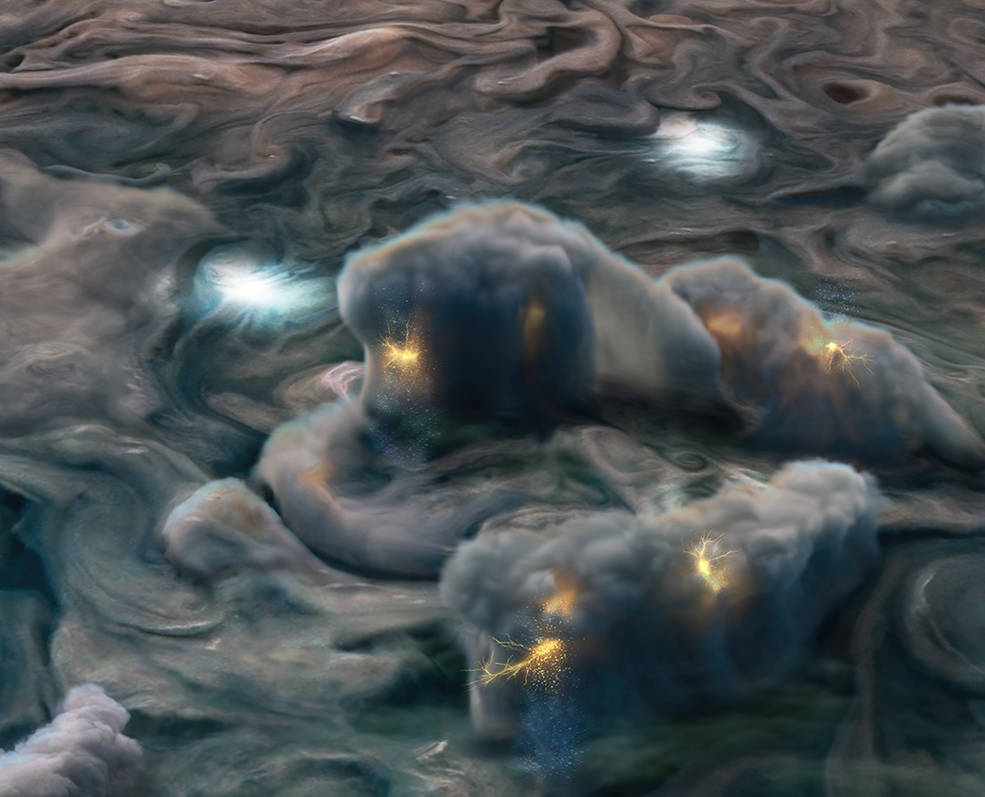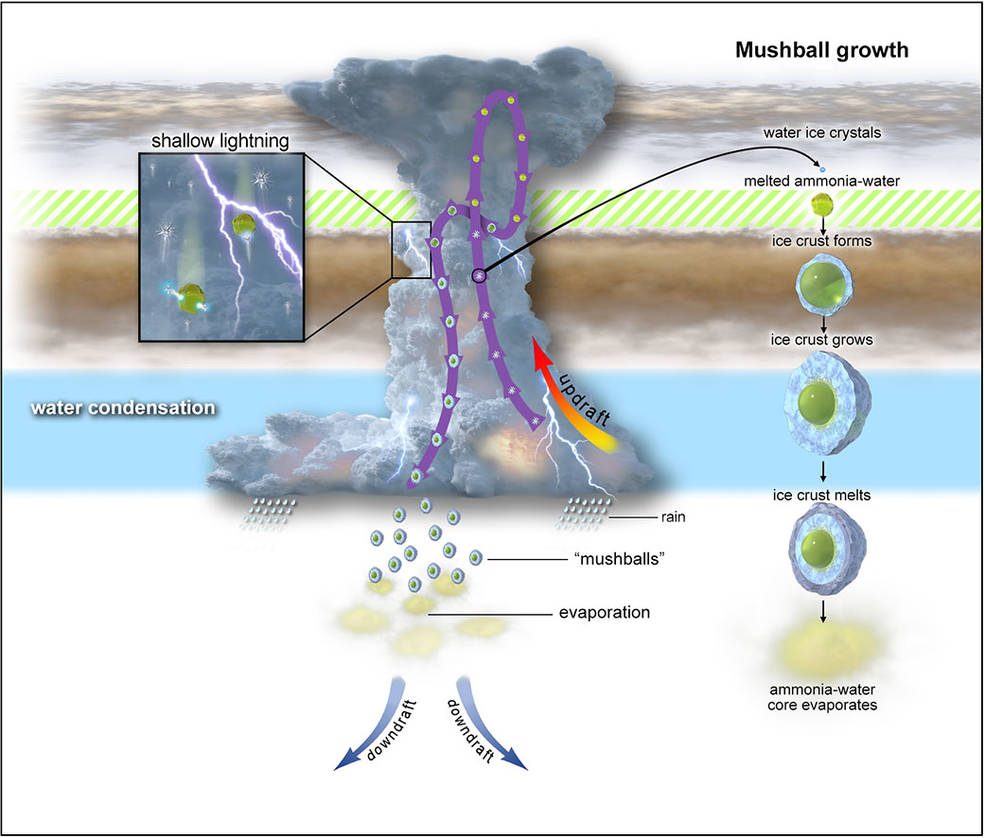Violent thunderstorms on Jupiter may form 'mushballs' that fall from the sky
Thunderstorms on Jupiter are so strong that ammonia-rich hail known as "mushballs" may fall from the sky.
New observations from NASA's Juno spacecraft at the gas giant planet could have implications for our understanding of giant planet atmospheres in general, which are largely made of gas and are subject to much higher pressures than what we are familiar with on Earth.
These observations also suggest that Jupiter has "shallow lightning", which happens in clouds containing ammonia and water. That's quite different than on Earth, where lightning originates in water clouds, according to a NASA statement.
Related: In photos: Juno's amazing views of Jupiter

"Juno's close flybys of the cloud tops allowed us to see something surprising – smaller, shallower flashes – originating at much higher altitudes in Jupiter's atmosphere than previously assumed possible," Heidi Becker, Juno's radiation monitoring investigation lead at NASA's Jet Propulsion Laboratory in California, said in the same statement. Becker is also lead author of a new paper in Nature, one of three new studies describing Juno's work.
Thunderstorms on Jupiter and Earth do have one thing in common: these natural phenomena move water about in the atmospheres of both planets. When NASA's Voyager spacecraft first spotted lightning at Jupiter in 1979, it was thought that both planets had similar kinds of lightning.

Voyager spotted lightning in Jupiter's cloud tops, which suggested the phenomenon originated in deep water clouds. Juno's new observations of nighttime flashes on Jupiter, however, reveal a more subtle story.
Get the Space.com Newsletter
Breaking space news, the latest updates on rocket launches, skywatching events and more!
On Jupiter, the thunderstorms are thought to form about 31 miles (50 km) below the visible bands and storms on the planet, where temperatures are close to the freezing point of water. Some of these storms are so powerful that they whisk crystal water-ice into the planet's upper atmosphere.
"At these altitudes, the ammonia acts like an antifreeze, lowering the melting point of water ice and allowing the formation of a cloud with ammonia-water liquid," Becker added in the same statement. "In this new state, falling droplets of ammonia-water liquid can collide with the upgoing water-ice crystals and electrify the clouds. This was a big surprise, as ammonia-water clouds do not exist on Earth."
The shallow lightning may also show why ammonia appears to be missing (or depleted) from Jupiter's atmosphere, and why ammonia appears in different concentrations in Jupiter's atmosphere.
"Previously, scientists realized there were small pockets of missing ammonia, but no one realized how deep these pockets went or that they covered most of Jupiter," Scott Bolton, Juno's principal investigator at the Southwest Research Institute in San Antonio, said in the same statement.
"We were struggling to explain the ammonia depletion with ammonia-water rain alone," Bolton added, "but the rain couldn't go deep enough to match the observations. I realized a solid, like a hailstone, might go deeper and take up more ammonia. When Heidi discovered shallow lightning, we realized we had evidence that ammonia mixes with water high in the atmosphere, and thus the lightning was a key piece of the puzzle."
The "mushballs" and depleted ammonia are described further in work published in the Journal of Geophysical Research: Planets in two parts, available here and here. When ice crystals combine with ammonia (a plentiful substance in Jupiter's atmosphere), the ammonia creates an "antifreeze" effect and changes the ammonia from ice to liquid.
When the mushballs fall into Jupiter's lower atmosphere, they drag down ammonia and water with them before eventually evaporating in the warmer temperatures. "That explains why we don't see much of it in these places with Juno's microwave radiometer," Tristan Guillot, a Juno co-investigator from the University of Côte d'Azur in Nice, France, and lead author of the two-part paper on ammonia and the mushballs, said in the NASA statement.
"As it turned out, the ammonia isn't actually missing; it is just transported down while in disguise, having cloaked itself by mixing with water," Bolton added. "The solution is very simple and elegant with this theory: When the water and ammonia are in a liquid state, they are invisible to us until they reach a depth where they evaporate – and that is quite deep."
Juno arrived at Jupiter almost exactly four years ago, on July 4, 2016, to better understand the origin and evolution of the planet. Juno's findings not only inform our understanding of solar system planets but also gas giant exoplanets, especially those of a similar size and formation history to planets in our solar system.
Editor's Note: This article was updated with new information, video and images from NASA.
Follow Elizabeth Howell on Twitter @howellspace. Follow us on Twitter @Spacedotcom and on Facebook.
Join our Space Forums to keep talking space on the latest missions, night sky and more! And if you have a news tip, correction or comment, let us know at: community@space.com.

Elizabeth Howell (she/her), Ph.D., was a staff writer in the spaceflight channel between 2022 and 2024 specializing in Canadian space news. She was contributing writer for Space.com for 10 years from 2012 to 2024. Elizabeth's reporting includes multiple exclusives with the White House, leading world coverage about a lost-and-found space tomato on the International Space Station, witnessing five human spaceflight launches on two continents, flying parabolic, working inside a spacesuit, and participating in a simulated Mars mission. Her latest book, "Why Am I Taller?" (ECW Press, 2022) is co-written with astronaut Dave Williams.









